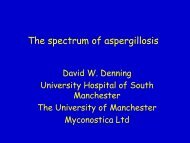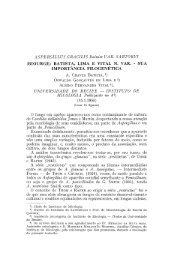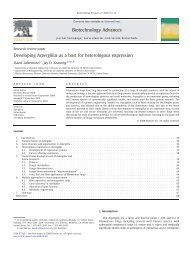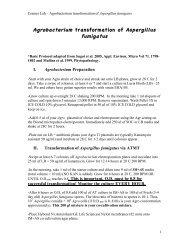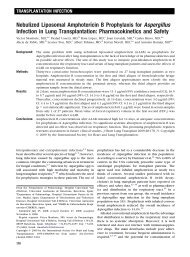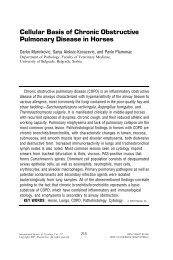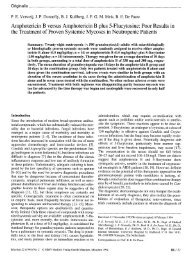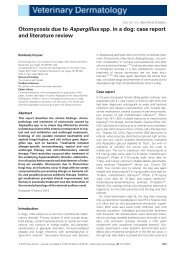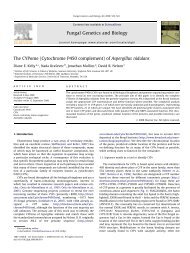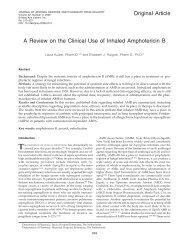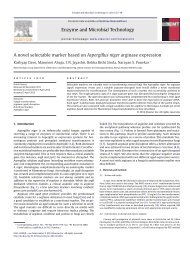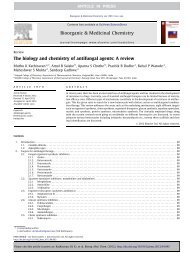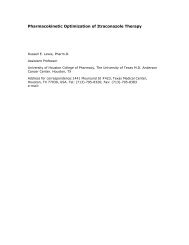BMC Infectious Diseases
BMC Infectious Diseases
BMC Infectious Diseases
Create successful ePaper yourself
Turn your PDF publications into a flip-book with our unique Google optimized e-Paper software.
<strong>BMC</strong> <strong>Infectious</strong> <strong>Diseases</strong><br />
This Provisional PDF corresponds to the article as it appeared upon acceptance. Fully formatted<br />
PDF and full text (HTML) versions will be made available soon.<br />
Five-Years Surveillance of invasive Aspergillosis in a University Hospital<br />
<strong>BMC</strong> <strong>Infectious</strong> <strong>Diseases</strong> 2011, 11:163 doi:10.1186/1471-2334-11-163<br />
Karolin Graf (graf.karolin@mh-hannover.de)<br />
Somayeh Mohammad Khani (mohammad-khani@mh-hannover.de)<br />
Ella Ott (ott.ella@mh-hannover.de)<br />
Frauke Mattner (mattnerf@kliniken-koeln.de)<br />
Petra Gastmeier (petra.gastmeier@charite.de)<br />
Dorit Sohr (dorit.sohr@charite.de)<br />
Stefan Ziesing (ziesing.stefan@mh-hannover.de)<br />
Iris F Chaberny (chaberny.iris@mh-hannover.de)<br />
ISSN 1471-2334<br />
Article type Research article<br />
Submission date 16 June 2010<br />
Acceptance date 8 June 2011<br />
Publication date 8 June 2011<br />
Article URL http://www.biomedcentral.com/1471-2334/11/163<br />
Like all articles in <strong>BMC</strong> journals, this peer-reviewed article was published immediately upon<br />
acceptance. It can be downloaded, printed and distributed freely for any purposes (see copyright<br />
notice below).<br />
Articles in <strong>BMC</strong> journals are listed in PubMed and archived at PubMed Central.<br />
For information about publishing your research in <strong>BMC</strong> journals or any BioMed Central journal, go to<br />
http://www.biomedcentral.com/info/authors/<br />
© 2011 Graf et al. ; licensee BioMed Central Ltd.<br />
This is an open access article distributed under the terms of the Creative Commons Attribution License (http://creativecommons.org/licenses/by/2.0),<br />
which permits unrestricted use, distribution, and reproduction in any medium, provided the original work is properly cited.
Five-Years Surveillance of invasive Aspergillosis in a University Hospital<br />
Karolin Graf 1§ , Somayeh Mohammad Khani 1* , Ella Ott 1* , Frauke Mattner 1, 2* , Petra<br />
Gastmeier 1, 3* , Dorith Sohr 3* , Stefan Ziesing 1* , Iris F. Chaberny 1*<br />
1 Institute for Medical Microbiology and Hospital Epidemiology, Hannover Medical School,<br />
Hannover, Germany<br />
2 Institute for Hygiene, University Hospital Witten-Herdecke, Campus Köln-Merheim,<br />
Germany<br />
3 Institute of Hygiene and Environmental Medicine, Charité - University Medicine Berlin,<br />
Germany<br />
Word count body text: 4311 words<br />
Word count summary: 296 words<br />
Part of this study was presented at the 20 th European Congress of Clinical Microbiology and<br />
<strong>Infectious</strong> <strong>Diseases</strong> (ECCMID). Vienna, Austria, 10 – 13 April 2010.<br />
*These authors contributed equally to this work<br />
§Corresponding author<br />
Email addresses:<br />
KG: graf.karolin@mh-hannover.de<br />
SM: mohammad-khani.somayeh@mh-hannover.de<br />
EO: ott.ella@mh-hannover.de<br />
FM: mattnerf@kliniken-koeln.de<br />
PG: petra.gastmeier@charite.de
DS: dorit.sohr@charite.de<br />
SZ: ziesing.stefan@mh-hannover.de<br />
IC: chaberny.iris@mh-hannover.de
ABSTRACT<br />
Background: As the most common invasive fungal infection, invasive aspergillosis<br />
(IA) remains a serious complication in immunocompromised patients, leading to increased<br />
mortality. Antifungal therapy is expensive and may result in severe adverse effects.<br />
The aim of this study was to determine the incidence of invasive aspergillosis (IA)<br />
cases in a tertiary care university hospital using a standardized surveillance method.<br />
Methods: All inpatients at our facility were screened for presence of the following<br />
parameters: positive microbiological culture, pathologist´s diagnosis and antifungal treatment<br />
as reported by the hospital pharmacy. Patients fulfilling one or more of these indicators were<br />
further reviewed and, if appropriate, classified according to international consensus criteria<br />
(EORTC).<br />
Results: 704 patients were positive for at least one of the indicators mentioned above.<br />
Applying the EORTC criteria, 214 IA cases were detected, of which 56 were proven, 25<br />
probable and 133 possible. 44 of the 81 (54%) proven and probable cases were considered<br />
health-care associated. 37 of the proven/probable IA cases had received solid organ<br />
transplantation, an additional 8 had undergone stem cell transplantation, and 10 patients were<br />
suffering from some type of malignancy. All the other patients in this group were also<br />
suffering from severe organic diseases, required long treatment and experienced several<br />
clinical complications. 7 of the 56 proven cases would have been missed without autopsy.<br />
After the antimycotic prophylaxis regimen was altered, we noticed a significant decrease (p =<br />
0.0004) of IA during the investigation period (2003-2007).<br />
Conclusion: Solid organ and stem cell transplantation remain important risk factors for<br />
IA, but several other types of immunosuppression should also be kept in mind. Clinical<br />
diagnosis of IA may be difficult (in this study 13% of all proven cases were diagnosed by<br />
autopsy only). Thus, we confirm the importance of IA surveillance in all high-risk patients.
Key words: surveillance, invasive Aspergillosis, epidemiology, pathology
BACKGROUND<br />
As the most common invasive fungal infection, invasive aspergillosis (IA) remains a<br />
serious complication in immunocompromised patients [1-3]. The number of patients at risk is<br />
increasing due to new intensive chemotherapy regimens and a growing number of stem cell<br />
and solid organ recipients. Because Aspergillus spp. are widely found in the environment,<br />
water, soil and in decomposing plants, spores can be easily inhaled and may then cause<br />
invasive pulmonary disease. The IA incidence in organ transplant recipients may be as high as<br />
5%; mortality rates of up to 80% have been reported [4]. Antifungal therapy is expensive and<br />
adverse effects can be severe [5]. Thus, the Centers for Disease Control and Prevention<br />
(CDC) recommend the need for surveillance of pulmonary IA in hospitals [6].<br />
Unfortunately, surveillance of IA is difficult to perform and various methods exist<br />
aiming to detect cases of IA using computerized data or chart review. Usually specially<br />
trained staff (qualified data review committee) are required to correctly evaluate cases [7-9].<br />
The aim of the five year surveillance study presented here was to obtain an overview<br />
of IA cases in the entire university hospital using a standardized surveillance method.<br />
METHODS<br />
Facility<br />
The study was conducted at Hannover Medical School, a 1,419-bed university hospital<br />
with 50,000 inpatient admissions per year. A large proportion of the patients are severely<br />
immunocompromised because Hannover Medical School focuses on transplantation of solid<br />
organs, stem cells and bone marrow. From 2003 through 2007, about 2,180 organ<br />
transplantations and 625 stem cell transplantations were performed. Intensive care units
(ICUs) and hematologic transplant units are equipped with HEPA air filtration and have<br />
positive air pressure (reverse isolation) rooms.<br />
Construction works<br />
Hannover Medical School was undergoing major construction and<br />
renovations during the entire study period. Work was also being carried out in<br />
patient care areas in clinical buildings. ICUs and non-ICUs were affected in equal<br />
measure. Units were only closed completely for extensive construction work. In<br />
order to prevent spread of Aspergillus spores, we introduced the following<br />
prevention measures as recommended by the CDC: (a) work sites were isolated<br />
with impermeable barriers, (b) specific routes were defined for transportation of<br />
materials, machines and building site workers, and (c) cleaning of units was<br />
intensified.<br />
Air sampling<br />
At Hannover Medical School, air sampling is performed routinely twice a year on<br />
ICU and hematologic-oncologic wards and was also performed throughout the<br />
duration of construction works.<br />
Air sampling was undertaken with one of the most frequently used air samplers, the<br />
Reuter centrifugal sampler (RCS High flow Air Sampler 35318, Biotest Diagnostics<br />
Corporation, Denville, NJ, USA).
Surveillance method and case definition<br />
The Department of Hospital Epidemiology and Infection Control reviewed the<br />
following data and classified IA cases as “proven”, “probable”, or “possible” according to<br />
European Organisation for Research and Treatment of Cancer (EORTC) criteria [10,11] .<br />
The first and most important step in the surveillance method employed here involved a<br />
microbiology database query using the keyword Aspergillus to retrieve possible cases of IA in<br />
microbiological samples.<br />
Data of all patients were reviewed for the following indicators:<br />
(a) Microbiology: An electronic alert was sent by the microbiological laboratory as soon as<br />
there were at least two positive results: either a positive culture for Aspergillus spp. (detection<br />
of septated hyphae) or serum found positive for Aspergillus antigen using the galactomannan<br />
Platelia Aspergillus test with a cut-off of 0.5 (Bio-Rad). The positive results were documented<br />
in a table via electronic retrieval, and then evaluated by our infection control team.<br />
(b) Pathology: Proof of mould infection in histological samples or in autopsy. Electronic<br />
retrieval involved searching for the keywords: mould, hyphae, mycosis, invasive mycosis,<br />
invasive aspergillosis, aspergillus. Medical reports including these keywords were evaluated<br />
by our infection control team. (c) Antimycotics: Use of at least one of the following<br />
substances was documented: amphotericin B, caspofungin, voriconazole, and flucytosine. The<br />
antimycotics are documented in an electronic program operated by the in-house pharmacy.<br />
The charts of all the patients who had received at least one of the antymycotics were<br />
evaluated by our infection control team. The reason for application (prophylaxis vs. therapy)<br />
as well as the type of application (oral vs. intravenous) was also recorded.<br />
In addition: Radiological findings that raised suspicion of mould infection (halo sign, air-<br />
crescent sign or other signs suggestive of invasive sinusitis). Patients showing one of the three<br />
symptoms were screened for radiological signs using the keywords mould infection,
aspergillosis, invasive aspergillosis, fungal infection, halo sign, crescent sign. Medical reports<br />
including these keywords were later evaluated by our infection control team.<br />
Most of these parameters were collected from the hospital’s patient data documentation<br />
system. Only autopsy reports had to be screened separately as they are not yet available<br />
electronically in our system<br />
We excluded cystic fibrosis patients who had not yet undergone lung transplantation<br />
because they are often colonized without invasive infection. Patients with invasive candidiasis<br />
were also excluded. All other inpatients were included in the study. A case of IA was<br />
classified as being likely to have been nosocomially acquired if clinical symptoms appeared<br />
more than seven days after admission with at least one negative respiratory culture before the<br />
positive index sample [7]. Cases with an infection occurring within seven days of admission<br />
were defined as possibly nosocomial.<br />
Cases positive for one or more of these indicators were then further evaluated using EORTC<br />
criteria including detailed chart review and audits with clinical personnel [10, 11]. We<br />
collected demographic data (age, gender), potential host factors that might predispose for IA,<br />
and clinical, microbiological and histological diagnoses.<br />
Infection was defined as early if occurring within the first 100 days of transplantation, and as<br />
late if detected later than 100 days.<br />
As the Department of Hospital Epidemiology and Infection Control, we are entrusted with<br />
analysis of data for surveillance purposes, and obtained full permission from our hospital’s<br />
administration to use of all the data generated.
Statistical analysis<br />
Monthly or annually incidence densities of nosocomial IA/1000 patient days were<br />
calculated as the number of patients with any IA event in a given month or year, divided by<br />
the number of patient days for that month or that year and multiplied by 1000.<br />
Mortality refers to in-hospital mortality only, because there was no post-discharge<br />
surveillance of patients and no surveillance of outpatients.<br />
Time trends of the five year surveillance programme were investigated. Differences of<br />
annual incidence densities were calculated using exponential MLE-Test. p values
RESULTS<br />
Characteristics of all IA cases<br />
During the study period, there were 234,095 admissions to Hannover Medical School.<br />
At least one of the pharmacological, pathological or microbiological indicators (in addition<br />
clinical and radiological signs) was reported in 704 patients. Only these cases had do be<br />
reviewed in more detail. Of this number, 214 cases of IA were confirmed as either proven<br />
(56; 26%), probable (25; 12%) or possible (133; 62%). 35 proven cases and 3 probable cases<br />
(overall 44% of all proven and probable cases) were classified as health-care associated. The<br />
number of indicators and the number of cases resulting are shown in table 1.<br />
58 of the 214 IA cases died (crude mortality rate 27%). Mortality rates differed<br />
depending on the classification of cases: 25 of 56 proven cases (46%), 11 of 25 probable<br />
cases (44%), and 22 of 133 possible cases (17%).<br />
The incidence of nosocomial IA (proven and probable cases) was 1.85% in organ transplanted<br />
patients (mostly from cardiothoracic surgery ICUs) and 0.97% in stem cell transplanted<br />
patients. We detected no Aspergillus outbreaks, nor did we find any correlation between the<br />
onset of IA and seasonal variation or construction works. Incidence densities declined when<br />
comparing data on invasive Aspergillosis from 2007 with those of 2003 (p=0.0004). Changes<br />
in incidence densities between the years are shown in table 2.<br />
Hospital-acquired cases of IA<br />
The air outlets of indoor air supply systems were checked regularly for presence of<br />
mould spores. Furthermore, the concentration of particles, bacteria and fungi was routinely<br />
measured inside and outside the building with no increase being noted during this study.<br />
Incidence rates of IA cases are shown in figure 1 and 2.
Characteristics of the 81 proven and probable IA cases<br />
The median age of proven and probable IA cases was 51 years (50 years on average,<br />
25 th percentile: 34 years; 75 th percentile: 63 years). There were 59 male and 32 female cases<br />
(male/female ratio 2.5). Underlying diseases of the proven and probable IA cases were (a)<br />
hematological diseases (n= 26; 21%), (b) severe chronic diseases of the lung (n=30; 24%), (c)<br />
liver diseases (n=20; 16%), (d) solid tumors (n=10; 12%), and (e) chronic renal diseases (n=7;<br />
6%).<br />
Detailed data on underlying diseases and distribution of organ transplantations for IA<br />
cases are shown in table 3 and 4.<br />
39 patients (48%) had transplantations (35 organ transplantations and 4 stem cell<br />
transplantations).<br />
44 of the proven and probable cases (44/81) were categorized as being of likely nosocomial<br />
origin, 19 cases (19/81) were possible nosocomial cases.<br />
28 of the likely nosocomial cases (28/39) were defined as early infection (up to 100<br />
days after transplantation); 11 likely nosocomial cases (11/39) showed late infection (detected<br />
>100 days).<br />
We identified 10 patients suffering from some kind of malignant tumor and a further<br />
26 patients with chronic organ diseases. Detailed information on the underlying diseases of<br />
these patients is given in table 4. All patients suffering from chronic organic diseases had<br />
received long term treatment, or had experienced severe complications (e.g. insufficiency of<br />
anastomoses, re-operations, or peritonitis). However, they had neither undergone<br />
transplantation, nor were they immunosuppressed..<br />
The mortality rate for all proven and probable cases was 45%. Seven of the 11 proven<br />
IA cases who had not received prior antifungal therapy died (64%). 72 proven/probable cases
(89%) had been treated with immunosuppressive therapy prior to first signs of IA (e.g. high<br />
dose steroidal therapy, cyclosporine, or chemotherapy). Most of the cases were detected in<br />
review of microbiology and pharmacy reports (58 cases, 72%). 34 cases (42%) had positive<br />
pathology results.<br />
Microbiological data<br />
Of the 81 proven and probable cases, Aspergillus sp. was identified in a clinical<br />
sample of 55 cases (68%). 34 cases (57%) had positive pathological results. 16 proven IA<br />
cases (29%) were detected by autopsy, seven of which did not have any other advance<br />
symptoms, meaning that 13% of all proven IA cases would have been missed without<br />
subsequent autopsy. Among the 133 possible cases, 49 had positive clinical samples (table 5).<br />
Data on antifungal therapy<br />
As shown in figure 3, the antifungal therapy regimen changed during the investigation<br />
period. Overall use of antimycotics increased (from 32,705 DDD in 2003 to 36,327 DDD in<br />
2007). However, use of flucytosine was terminated in 2005. Instead, posaconazole was<br />
introduced in 2006, with consumption increasing by factor 7 in 2007 (from 131 to 998 DDD).<br />
Anidulafungin was introduced in 2007 (27 DDD). A reduction in use of amphotericin B (from<br />
7786 to 5164 DDD) and itraconazole (from 7,964 to 4,489 DDD) became apparent during the<br />
study, while use of caspofungin (from 1,582 to 4,080 DDD) and voriconazole (from 2,141 to<br />
5,311 DDD) increased.<br />
During the investigation period, the departments of hemato-oncology and cardio-thoracic<br />
surgery implemented standardized long-term prophylaxis for all transplanted patients<br />
(Initially 1x200mg, followed by 2x200mg itraconazole daily). Hence, pharmacological<br />
reports did not add to detection of further cases of IA. Only cases found in pharmacological<br />
alerts were evaluated by our infection control team. Not a single case of proven, probable or
possible IA could be confirmed. All the cases detected were positive for at least one of the<br />
other alerts.<br />
DISCUSSION<br />
Surveillance of IA is important because it is the only way minor trends and major<br />
changes in incidence density can be detected over time. Furthermore, it may help identify IA<br />
cases in patients with various coexisting organ diseases (which can make diagnosis difficult).<br />
Thus, the CDC and several other experts in the field of IA prevention recommend<br />
surveillance. Unfortunately, however, so far, there is no standardized epidemiological method<br />
available to do so.<br />
In this investigation, we used a simplified surveillance alert system that relied on three<br />
indicators to detect possible cases of IA. This process allowed to screen for IA in the entire<br />
hospital (not only in hematology) and to detect possible clusters of cases especially in other<br />
disciplines. Our data show that IA may occur in all types of medical departments, and in all<br />
kinds of patients with severe underlying diseases.<br />
Our surveillance system was implemented in 2003 and ended in 2007, which is why we did<br />
not apply the revised EORTC criteria published later in 2008. Application of the revised<br />
criteria in future studies covering a different set of patients (e.g. patients with solid organ<br />
transplantations, hereditary immunodeficiencies and connective diseases) should by all means<br />
be considered, bearing in mind, however, that the category of proven invasive fungal disease<br />
can now apply to any patient, regardless of whether the patient is immunocompromised,<br />
whereas probable and possible categories are proposed for immunocompromised patients<br />
only. Because we would wish to include all patients the revised EORTC criteria might [12]<br />
not be helpful. Definition of nosocomial IA remains difficult. A better understanding of early<br />
events related to IA onset will help improve treatment of this disease, for which the prognosis
emains negative. Thus, in the study presented here, infections were defined as early if<br />
occurring within 100 days of transplantation and as late if detected later than 100 days. To our<br />
knowledge, a clear definition of nosocomial infection can only be given if there is at least one<br />
negative respiratory culture after admission [7]. Cases with an infection occurring within<br />
seven days after admission without a negative culture prior to a positive result still remain<br />
uncertain and were thus defined as possibly nosocomial<br />
The majority of patients with IA had a history of transplantation (visceral, cardiac, and<br />
thoracic surgery) (94; 44%). Only 72 (34%) of the IA cases were cared for in hematology or<br />
in infectious diseases units. This unexpected distribution has been reported previously [13].<br />
Our findings therefore implicate that IA surveillance needs to be extended and should<br />
comprise the entire hospital including all high risk units [9]. Accordingly, alert systems that<br />
might already be in place for hematological patients should be expanded to patients after<br />
organ transplantation and patients with other severe chronic diseases.<br />
Compared with the literature, we noticed a significant decrease in the incidence<br />
density of IA and low rates from 2005 through 2007 [13], which probably reflects changes in<br />
antimycotic prophylaxis policy. During 2003 and 2004, antimycotic prophylaxis was<br />
implemented in several high risk units. For example, the departments of hemato-oncology and<br />
the cardio-thoracic surgery implemented a standardized prophylaxis protocol for transplanted<br />
patients, which led to a significant decrease in the number of cases.<br />
Pharmacological reports did not lead to detection of additional cases of IA. Not a single case<br />
of proven, probable or possible IA could be confirmed by means of this indicator alone. All<br />
the cases detected were positive for at least one of the other indicators. However, we<br />
suggested maintaining the indicator for surveillance purposes because it was an important<br />
point of discussion between clinicians and infection control team. During prospective<br />
surveillance, this indicator was helpful in encouraging clinicians intensify microbiological<br />
diagnostics, which was essential for categorization of IA.
In terms of case investigation, it is important to emphasize that chart review and audits<br />
with clinical personnel is crucial for all potential cases presenting with symptoms matching<br />
one of the indicators we were using. Other authors who also use an active surveillance system<br />
report that although computer-assisted surveillance may be quite sensitive, it is not very<br />
specific [14]. This is why we established the method of surveillance presented here. However,<br />
extensive chart review is only necessary if patients present a positive indicator. This way, we<br />
had the possibility to quickly screen 234,095 patients admitted during 2003 through 2007, but<br />
only 704 of that number required a more detailed review. There are other simplified<br />
surveillance methods in place, but they showed to be suitable for special patient groups only,<br />
while further clarification often remains impossible due to the lack of additional clinical data<br />
[14].<br />
Reliance on microbiological data alone to identify cases may lead to ascertainment bias,<br />
because many cases of IA are diagnosed radiographically, by pathologic investigation or by<br />
clinical suspicion. Our method, which includes three indicators that are as far as possible<br />
standardized, may also be suitable for use in other institutions, and might even facilitate inter-<br />
institutional comparison of incidence rates in special patient groups or in all patients.<br />
The EORTC criteria used in our study represent the first established international<br />
criteria for definition of IA. They were primarily developed for immunocompromised patients<br />
with cancer and hematologic stem cell transplantation; however, as shown here, they are also<br />
applicable to other patient groups. Nevertheless, caution should be exercised in applying the<br />
criteria. Only 56 (26%) of the 214 cases of IA investigated were proven, 25 (12%) were<br />
probable, whereas, according to these criteria, the majority (133; 62%) were possible cases.<br />
With regard to the possible cases, the true diagnosis remains to some extent uncertain.<br />
Clinical diagnosis, microbiological findings and the pathologic results may differ. If certain<br />
data - especially microbiological and pathologic results - are missing, the correct diagnosis
can also easily be missed. It is an important fact that the number of respiratory samples taken<br />
may also influence the number of cases. We noticed this effect in our surveillance study<br />
because we included the whole hospital over a long time, and different culturing regimes (e.g.<br />
routine culturing of tracheal secretions or screening at admission in some ICUs) were used in<br />
various departments at our facility.<br />
For inter-institutional comparison of incidences it is important to calculate the rates of<br />
possible and probable nosocomial cases. In this study, 32 of the proven cases (57%) had<br />
positive pathology results, 16 (29%) were detected in autopsy and seven cases did not match<br />
any other alerts, meaning that 13% of all proven cases would not have been detected without<br />
autopsy. From 2003 through 2007, autopsy rates at our hospital ranged between 14.1% and<br />
20.9%, and decreased during the investigation period. Thus, we surmise that some cases were<br />
missed because of lacking autopsy. In Germany, autopsy rates have decreased steadily since<br />
1980 and are the lowest in the world today [15]. Thus, studies carried out under these<br />
circumstances may underestimate the actual problem.<br />
We documented antifungal therapy such as amphotericin B, voriconazole and<br />
caspofungin. In our study, reports from the in-house pharmacy did not help detect diseased<br />
patients. However, they can help identify risk patients. On the one hand, many patients<br />
received antifungal treatment although we found that the criteria were uncertain for IA. On<br />
the other hand, antifungal drugs are used for prophylaxis, especially in transplanted patients<br />
[4]. Obviously clinicians are often uncertain about the indication for antimycotic therapy or<br />
aim to prevent colonization in the first place [16]. IA is often seen in patients with different<br />
severe chronic organ diseases, making it difficult to get the diagnosis right without hard<br />
microbiological and / or pathological data. Even under adequate antifungal therapy, mortality<br />
rates of between 30% and 80% are reported for IA, and antifungal drugs might be used for<br />
prophylaxis more often than for therapy [17]. It is worth noting that pharmacological data<br />
may be supportive for detection of IA cases, although they are of little help for direct
detection. During prospective surveillance these data may serve as a first step for contacting<br />
clinicians, and for discussing diagnostic procedures, infection control measures and treatment<br />
options. Patients undergoing immunosuppressive therapy have often been reported to be “high<br />
risk” patients for acquiring IA, and especially patients suffering from hematological diseases<br />
and / or with stem cell transplantation [18-19]. We are able to confirm these findings since we<br />
also found a large number of IA in transplanted patients, but also in patients with solid organ<br />
malignancy tumors. Two patients were undergoing chemotherapy and three other patients<br />
were receiving high dose steroidal therapy. Due to the rather small number of patients we<br />
cannot define the presence of a solid tumor as an independent risk factor; however, we do<br />
recommend that patients with malignancies should be included in a surveillance programme.<br />
In our study, the incidence of likely nosocomial IA (proven and probable cases) was 1.85% in<br />
organ transplanted patients and 0.97% in stem cell transplanted patients. In other studies, the<br />
incidence of IA was evaluated as a frequency of 1 to 28% for patients with allogenous bone<br />
marrow transplant graft [14, 19]. IA incidence rates for solid organ transplant patients varied<br />
depending on the type of transplanted organ: 2 to 18% for lung [20-22], 1.5 to 10% for liver<br />
[23-24] and 1.3 to 7% for heart [25-27].<br />
The concentration of Aspergillus spores in the surrounding air may also influence the<br />
likelihood of subsequent infection. Fortunately, during the 60 months of epidemiological<br />
surveillance, no outbreaks or clusters and no association between the onset of IA and seasons<br />
was observed.<br />
In our study, crude mortality (45%) for proven and probable IA cases was relatively<br />
low compared with the findings of others (50–100%) [26-28]. Since patients with IA often<br />
suffer from severe underlying diseases, we cannot say with full certainty whether IA was<br />
causative for or at least contributed to their fatal outcome. Thus, the role of IA sometimes<br />
remains unknown. Some patients may be colonized with Aspergillus spp. for a long time<br />
before developing terminal IA. In this case, IA may rather serve as a sign of the severity of
immunosuppression due to some other illness. In our study (34 deceased patients), the time<br />
frame from IA diagnosis to death was only eight days in median, however, culturing of the<br />
micro-organism may take several days. Thus, clinicians may not have enough time to choose<br />
and introduce the appropriate treatment.<br />
Our data show that surveillance of IA should be implemented in all areas of the<br />
hospital that care for severely ill patients. A multidisciplinary working group of infection<br />
control staff, microbiologists, pharmacologists and clinicians would give a straightforward<br />
approach to IA surveillance and help clinicians detect all kinds of high risk patients and cases<br />
of IA more easily and at an earlier stage. Our five year survey shows a high frequency of IA<br />
cases in patients hospitalized in units other than hematology. Thus, our study emphasizes the<br />
importance of IA surveillance, not just in hematology units; rather, surveillance should be<br />
expanded to cover all high-risk units (ICUs, respiratory care, infectious diseases and internal<br />
medicine units, in particularly).<br />
CONCLUSIONS<br />
This study provides an overview on the incidence of IA cases in a university hospital<br />
through use of a standardized surveillance system. It confirms previous findings on patient<br />
groups, prophylaxis and treatment options and provides new insights into certain aspects of<br />
IA surveillance covering the entire hospital.<br />
Only the charts of 704 of 234,095 patients admitted (0.003%) over a five year time frame<br />
(2003 to 2007) required more intensive reviewing as those patients had at least one special<br />
indicator (microbiology, pathology, pharmacology). Yet, diagnosis remains difficult because<br />
13% of the cases were diagnosed by autopsy only.<br />
One should keep in mind that so-called “high risk” patients for IA are not only those<br />
undergoing transplantation, but all other patients receiving immunosuppressive therapy. Thus,
this type of surveillance approach should be performed hospital-wide and should include all<br />
patients that are potentially at increased risk of IA.<br />
ABBREVIATIONS<br />
CDC: Centers for Disease Control and Prevention<br />
DDD: daily defined dosages<br />
EORTC: European Organisation for Research and Treatment of Cancer<br />
HEPA: high efficacy particulate air<br />
IA: invasive aspergillosis<br />
ICUs: intensive care units<br />
COMPETING INTERESTS<br />
The authors declare that they have no competing interests.<br />
AUTOR´S CONTRIBUTIONS<br />
KG: data collection and evaluation, manuscript draft. SM: data collection and evaluation. EO:<br />
performance of statistical analysis and evaluation. FM: data collection and evaluation in<br />
transplanted patients, supported manuscript draft. PG: participation in the design of the study<br />
and supervision, supported manuscript draft. DS: performance of statistical analysis and<br />
evaluation. SZ: generation of microbiological data. IC: study conceive, participation in the<br />
design of the study, evaluation and coordination. All authors read and approved the final<br />
manuscript.<br />
ACKNOWLEDGEMENTS
We would like to thank all the physicians of Hannover Medical School, Zuleyha Demir, the<br />
Center for Radiology, the Pharmacy and the Institute for Pathology who contributed to IA<br />
Surveillance.
REFERENCES<br />
1. Burghi G, Lemiale V, Bagnulo H, Bodega E, Azoulay E: [Invasive pulmonary<br />
aspergillosis in a hematooncological patient in the intensive care units. A review of<br />
the literature.]. Med Intensiva 2010;34:459-66.<br />
2. Cornet M, Fleury L, Maslo C, Bernard JF, Brucker G: Epidemiology of invasive<br />
aspergillosis in France: a six-year multicentric survey in the Greater Paris area. J<br />
Hosp Infect 2002, 51: 288-296.<br />
3. Singh N, Husain S: Invasive aspergillosis in solid organ transplant recipients. Am J<br />
Transplant 2009, 9 Suppl 4: S180-S191.<br />
4. Mattner F, Chaberny IF, Weissbrodt H, Fischer S, Gastmeier P, Haubitz B et al.:<br />
[Surveillance of invasive mold infections in lung transplant recipients: effect of<br />
antimycotic prophylaxis with itraconazole and voriconazole]. Mycoses 2005, 48<br />
Suppl 1: 51-55.<br />
5. Blot S, Piette A, Vandijck D, Lizy C, Vandewoude K, Vogelaers D: The economic<br />
impact of invasive aspergillosis in intensive care unit patients. Int J Infect Dis<br />
2010;14:e536-7.<br />
6. Weber DJ, Peppercorn A, Miller MB, Sickbert-Benett E, Rutala WA: Preventing<br />
healthcare-associated Aspergillus infections: review of recent CDC/HICPAC<br />
recommendations. Med Mycol 2009, 47 Suppl 1: S199-S209.<br />
7. Pegues CF, Daar ES, Murthy AR: The epidemiology of invasive pulmonary<br />
aspergillosis at a large teaching hospital. Infect Control Hosp Epidemiol 2001, 22:<br />
370-374.<br />
8. Pappas PG, Alexander BD, Andes DR, Hadley S, Kauffman CA, Freifeld A et al.:<br />
Invasive fungal infections among organ transplant recipients: results of the<br />
Transplant-Associated Infection Surveillance Network (TRANSNET). Clin Infect<br />
Dis 2010, 50: 1101-1111.<br />
9. Kontoyiannis DP, Marr KA, Park BJ, Alexander BD, Anaissie EJ, Walsh TJ et al.:<br />
Prospective surveillance for invasive fungal infections in hematopoietic stem cell
transplant recipients, 2001-2006: overview of the Transplant-Associated Infection<br />
Surveillance Network (TRANSNET) Database. Clin Infect Dis 2010, 50: 1091-1100.<br />
10. Ascioglu S, Rex JH, de Pauw B, Bennett JE, Bille J, Crokaert F et al.: Defining<br />
opportunistic invasive fungal infections in immunocompromised patients with<br />
cancer and hematopoietic stem cell transplants: an international consensus. Clin<br />
Infect Dis 2002, 34: 7-14.<br />
11. Tablan OC, Anderson LJ, Besser R, Bridges C, Hajjeh R: Guidelines for preventing<br />
health-care--associated pneumonia, 2003: recommendations of CDC and the<br />
Healthcare Infection Control Practices Advisory Committee. MMWR Recomm Rep<br />
2004, 53: 1-36.<br />
12. De Pauw B, Walsh TJ, Donnelly JP, Stevens DA, Edwards JE, Calandra T et al.:<br />
Revised definitions of invasive fungal disease from the European Organization for<br />
Research and Treatment of Cancer/Invasive Fungal Infections Cooperative Group<br />
and the National Institute of Allergy and <strong>Infectious</strong> <strong>Diseases</strong> Mycoses Study Group<br />
(EORTC/MSG) Consensus Group. Clin Infect Dis 2008, 46: 1813-1821.<br />
13. Fourneret-Vivier A, Lebeau B, Mallaret MR, Brenier-Pinchart MP, Brion JP, Pinel C et<br />
al.: Hospital-wide prospective mandatory surveillance of invasive aspergillosis in a<br />
French teaching hospital (2000-2002). J Hosp Infect 2006, 62: 22-28.<br />
14. Chang DC, Burwell LA, Lyon GM, Pappas PG, Chiller TM, Wannemuehler KA et al.:<br />
Comparison of the use of administrative data and an active system for surveillance<br />
of invasive aspergillosis. Infect Control Hosp Epidemiol 2008, 29: 25-30.<br />
15. Brinkmann B, Du CA, Vennemann B: [Recent data for frequency of autopsy in<br />
Germany]. Dtsch Med Wochenschr 2002, 127: 791-795.<br />
16. Erjavec Z, Kluin-Nelemans H, Verweij PE: Trends in invasive fungal infections, with<br />
emphasis on invasive aspergillosis. Clin Microbiol Infect 2009, 15: 625-633.<br />
17. Marr KA, Boeckh M, Carter RA, Kim HW, Corey L: Combination antifungal therapy<br />
for invasive aspergillosis. Clin Infect Dis 2004, 39: 797-802.<br />
18. Minari A, Husni R, Avery RK, Longworth DL, DeCamp M, Bertin M et al.: The<br />
incidence of invasive aspergillosis among solid organ transplant recipients and
implications for prophylaxis in lung transplants. Transpl Infect Dis 2002, 4: 195-<br />
200.<br />
19. Wingard JR, Beals SU, Santos GW, Merz WG, Saral R: Aspergillus infections in bone<br />
marrow transplant recipients. Bone Marrow Transplant 1987, 2: 175-181.<br />
20. Guillemain R, Lavarde V, Amrein C, Chevalier P, Guinvarc'h A, Glotz D: Invasive<br />
aspergillosis after transplantation. Transplant Proc 1995, 27: 1307-1309.<br />
21. Guillemain R, Lavarde V, Amrein C, Chevalier P, Guinvarc'h A, Glotz D:<br />
[Aspergillosis and renal, heart and lung transplantation]. Pathol Biol (Paris) 1994,<br />
42: 661-669.<br />
22. Cahill BC, Hibbs JR, Savik K, Juni BA, Dosland BM, Edin-Stibbe C et al.: Aspergillus<br />
airway colonization and invasive disease after lung transplantation. Chest 1997,<br />
112: 1160-1164.<br />
23. Singh N, Wagener MM, Cacciarelli TV, Levitsky J: Antifungal management practices<br />
in liver transplant recipients. Am J Transplant 2008, 8: 426-431.<br />
24. Kusne S, Torre-Cisneros J, Manez R, Irish W, Martin M, Fung J et al.: Factors<br />
associated with invasive lung aspergillosis and the significance of positive<br />
Aspergillus culture after liver transplantation. J Infect Dis 1992, 166: 1379-1383.<br />
25. Hofflin JM, Potasman I, Baldwin JC, Oyer PE, Stinson EB, Remington JS: <strong>Infectious</strong><br />
complications in heart transplant recipients receiving cyclosporine and<br />
corticosteroids. Ann Intern Med 1987, 106: 209-216.<br />
26. Meersseman W, Lagrou K, Maertens J, Van Wijngaerden E: Invasive aspergillosis in<br />
the intensive care unit. Clin Infect Dis 2007, 45: 205-216.<br />
27. Lau CL, Patterson GA, Palmer SM: Critical care aspects of lung transplantation. J<br />
Intensive Care Med 2004, 19: 83-104.<br />
28. Cornet M, Fleury L, Maslo C, Bernard JF, Brucker G: Epidemiology of invasive<br />
aspergillosis in France: a six-year multicentric survey in the Greater Paris area. J<br />
Hosp Infect 2002, 51: 288-296.
TABLE 1: Cases found through indicators and IA cases resulting (with each method)<br />
all<br />
cases<br />
cases with one<br />
indicator<br />
cases with two<br />
indicators<br />
cases with three<br />
indicators<br />
M* PA* M, PH* M, PA* PH, PA* M, PH, PA*<br />
no IA 490 231 6 253 - - -<br />
proven IA 56 3 6 17 13 2 15<br />
probable IA 25 6 - 17 - 1 1<br />
possible IA 133 45 - 88 - - -<br />
* M = Microbiological indicator, PA = Pathological indicator, PH = Pharmacological<br />
indicator<br />
TABLE 2: Incidence densities of IA<br />
year<br />
# of cases<br />
(proven and<br />
probable)<br />
# of patient<br />
days<br />
incidence<br />
density<br />
(per 100,000<br />
patient days)<br />
95% CI p-value<br />
(vs. 2003)<br />
2003 32 391.445 24 5.59; 11.54 -<br />
2004 16 407.007 15 2.25; 6.38 0.008<br />
2005 15 407.644 6 2.06; 6.07 0.427<br />
2006 7 415.980 5 0.68; 3.47 0.044<br />
2007 11 431.954 4 1.27; 4.56 0.804
TABLE 3: Underlying diseases for all confirmed cases of invasive aspergillosis<br />
underlying diseases proven +<br />
probable<br />
n=81<br />
possible<br />
n= 133<br />
total (%)<br />
n= 214<br />
hematological diseases 17 (38%) 55 (41%) 72 (34%)<br />
organ transplantation 39 (49%) 55 (41%) 94 (44%)<br />
single lung transplantation<br />
double lung transplantation<br />
liver transplantation<br />
heart transplantation<br />
heart-lung transplantation<br />
renal transplantation<br />
stem cell transplantation<br />
pancreas transplantation<br />
liver diseases 12 14 26<br />
lung diseases 15 31 4<br />
kidney diseases 4 4 8<br />
heart diseases 4 1 5<br />
heart and lung diseases 3 5 10<br />
pancreas diseases 1 0 1<br />
malignancy (solid tumor) 10 (22%) 6 (5%) 15 (7%)<br />
human immunodeficiency virus 0 0 0<br />
immunosuppressive treatment 73<br />
1<br />
13<br />
9<br />
4<br />
3<br />
4<br />
4<br />
1<br />
(85%)<br />
2<br />
23<br />
12<br />
2<br />
3<br />
0<br />
13<br />
0<br />
117<br />
(88%)<br />
3<br />
36<br />
21<br />
6<br />
6<br />
4<br />
17<br />
1<br />
190<br />
(89%)
TABLE 4: Underlying diseases for proven and probable cases of invasive aspergillosis (IA)<br />
without transplantation or primary immunosuppression<br />
underlying diseases / therapy proven +<br />
probable IA<br />
n= 81<br />
total (all proven and<br />
probable cases) (%)<br />
tumor diseases 10 12.3%<br />
colorectal cancer (colectomy, rectal resection)<br />
gastric cancer (gastrectomy)<br />
cholangiocarcinoma (tumor resection)<br />
hepatocellular carcinoma<br />
renal carcinoma (nephrectomy)<br />
4<br />
2<br />
1<br />
2<br />
1<br />
4.9%<br />
2.5%<br />
1.2%<br />
2.5%<br />
1.2%<br />
other diseases 26 32.5%<br />
gastroenterologic diseases<br />
necrotizing enterocolitis<br />
necrotizing pancreatitis<br />
chronical hepatitis B infection<br />
liver cirrhosis<br />
citrullinaemia<br />
10<br />
1<br />
2<br />
3<br />
3<br />
1<br />
12.3%<br />
1.2%<br />
2.5%<br />
3.7%<br />
3.7%<br />
1.2%<br />
prematurity 1 1.2%<br />
heart diseases<br />
congenital heart disease<br />
dilatative cardiomyopathy<br />
endocarditis<br />
4<br />
1<br />
2<br />
1<br />
4.9%<br />
1.2%<br />
2.5%<br />
1.2%<br />
vascular diseases 1 1.2%
type B dissection (stent implantation) 1 1.2%<br />
renal diseases<br />
renal insufficiency<br />
other diseases<br />
multiple trauma<br />
sinusitis maxillaris<br />
4<br />
4<br />
5<br />
3<br />
2<br />
6.2%<br />
4.9%<br />
6.2%<br />
3.7%<br />
2.5%
TABLE 5: Classification of invasive aspergillosis by positive microbiological culture<br />
positive microbiological samples/ alerts proven<br />
n=56<br />
probable<br />
n= 25<br />
possible<br />
n= 133<br />
total<br />
n= 214 (%)<br />
microbiological culture 41 17 49 107 (50%)<br />
broncho alveolar lavage 20 14 27 61 (29%)<br />
bronchial secretion 13 7 26 46 (21%)<br />
tracheal secretion 14 9 26 40 (19%)<br />
Figure 1: Monthly incidence of invasive Aspergillosis (IA)<br />
Figure 2: Yearly incidence densities of invasive Aspergillosis (IA)<br />
Figure 3: Usage of antifungal therapy calculated per 1000 Patient days
60<br />
50<br />
40<br />
30<br />
20<br />
10<br />
0<br />
Figure 1<br />
Jan-03<br />
May-03<br />
Sep-03<br />
Jan-04<br />
May-04<br />
Sep-04<br />
Jan-05<br />
May-05<br />
Sep-05<br />
Jan-06<br />
May-06<br />
Sep-06<br />
Jan-07<br />
May-07<br />
Sep-07<br />
Total IA<br />
Proven and probable IA
9<br />
8<br />
7<br />
6<br />
5<br />
4<br />
3<br />
2<br />
1<br />
0<br />
Figure 2<br />
2003 2004 2005 2006 2007<br />
Proven and<br />
probable IA<br />
Nosocomial<br />
proven and<br />
probable IA
25,00<br />
20,00<br />
15,00<br />
10,00<br />
5,00<br />
0,00<br />
Figure 3<br />
2003 2004 2005 2006 2007<br />
Amphotericin B<br />
Caspofungin<br />
Anidulafungin<br />
Posaconazole<br />
Itraconazole<br />
Voriconazole<br />
Flucytosine



